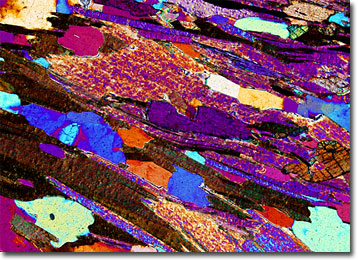Polarized Light Microscopy Digital Image Gallery
Mica Schist
Schists are crystalline rocks with a foliated structure that enables them to be easily divided into layers. The majority of schists are primarily comprised of platy minerals, such as micas.

Micas are a group of minerals that are characterized by their ability to easily separate into thin, relatively flexible sheets or plates. Present in various forms around the world, the hue of mica ranges from colorless to brown, black, and green, and largely depends upon the mineralís iron content. The most economically important micas are phlogopite, which is rich in magnesium, and muscovite, which is potassium based. Utilized in sheets, as scraps, or ground, both have found use in a variety of products, such as paints, tiles, and wallpaper. The micas are also often utilized as an insulating material.
The most common schist that occurs on Earth is mica schist, which essentially consists of quartz and mica, but may also contain some feldspar. Similar to other schists, mica schist is metamorphic and flakes of its component minerals (usually muscovite or biotite) are visible to the unaided eye. Abundant amid Precambrian rocks, a variety of valuable materials may be interbedded with mica schists. For example, ancient Egyptians mined massive quantities of mica schist to find emeralds, which have also since been found in mica schists in Austria and the Russian Urals. Similarly, other types of beryl, aventurine, and even marble, are frequently found amid deposits of mica schist.
